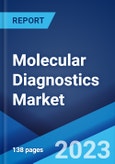The global molecular diagnostics market size reached US$ 18.5 Billion in 2022. Looking forward, the publisher expects the market to reach US$ 27.4 Billion by 2028, exhibiting a growth rate (CAGR) of 6.5% during 2023-2028.
Molecular diagnostics refers to a set of laboratory tests that sequences the deoxyribonucleic acid (DNA), ribonucleic acid (RNA), or cell proteins of an individual to analyze biomarkers of potential diseases. It assists in diagnosing and monitoring infections and diseases, detecting risks, and assessing therapy response. In recent years, molecular diagnostics has rapidly gained traction in oncology, pharmacogenomics, microbiology, infectious diseases, genetic disease screening, and blood screening. With recent advancements, molecular diagnostics has become an essential aspect of patient-tailored interventions and therapeutics, which is escalating its demand across the globe.
Molecular diagnostics refers to a set of laboratory tests that sequences the deoxyribonucleic acid (DNA), ribonucleic acid (RNA), or cell proteins of an individual to analyze biomarkers of potential diseases. It assists in diagnosing and monitoring infections and diseases, detecting risks, and assessing therapy response. In recent years, molecular diagnostics has rapidly gained traction in oncology, pharmacogenomics, microbiology, infectious diseases, genetic disease screening, and blood screening. With recent advancements, molecular diagnostics has become an essential aspect of patient-tailored interventions and therapeutics, which is escalating its demand across the globe.
Molecular Diagnostics Market Trends:
Molecular diagnostics is widely used by hospitals, laboratories, and research institutes for early detection of diseases, coagulation, and human leukocyte antigen typing. As a result, the rising prevalence of chronic conditions, such as cancer, cardiovascular diseases (CVDs), neurological disorders, and infectious diseases, represents the primary factor driving the market growth. Besides this, the growing geriatric population that is more susceptible to developing numerous medical ailments and the widespread adoption of point-of-care (POC) testing devices are catalyzing the product demand. Additionally, the recent outbreak of coronavirus disease (COVID-19) has accelerated the adoption of molecular diagnostic methods, such as polymerase chain reaction (PCR), for COVID-19 testing. Along with this, several favorable initiatives undertaken by the governing agencies and regulatory authorities of various countries, such as fast approvals of diagnostic products to help curb the spread of the virus, are also propelling the market growth. Furthermore, the leading players are making heavy investments to launch innovative diagnostic devices that offer enhanced accuracy, flexibility, cost-effectiveness, and faster results to expand their product portfolio and gain a competitive edge. Other factors, including the escalating demand for personalized treatment, the emerging trend of preventive medicine, improving healthcare infrastructure, and technological advancements, are also creating a positive market outlook.Key Market Segmentation:
The publisher provides an analysis of the key trends in each sub-segment of the global molecular diagnostics market report, along with forecasts at the global, regional and country level from 2023-2028. The report has categorized the market based on product, technology, application and end users.Breakup by Product:
- Reagents and Kits
- Instruments
- Software and Services
Breakup by Technology:
- Polymerase Chain Reactions (PCR)
- Hybridization
- DNA Sequencing
- Microarray
- Isothermal Nucleic Acid Amplification Technology (INAAT)
- Others
Breakup by Application:
- Infectious Diseases Diagnostics
- Oncology
- Genetic Testing
- Blood Screening
- Others
Breakup by End Users:
- Hospitals
- Laboratories
- Others
Breakup by Region:
- North America
- United States
- Canada
- Asia-Pacific
- China
- Japan
- India
- South Korea
- Australia
- Indonesia
- Others
- Europe
- Germany
- France
- United Kingdom
- Italy
- Spain
- Russia
- Others
- Latin America
- Brazil
- Mexico
- Others
- Middle East and Africa
Competitive Landscape:
The competitive landscape of the industry has also been examined along with the profiles of the key players being Abbott Laboratories, Agilent Technologies Inc., Becton Dickinson and Company, Biomerieux SA, Danaher Corporation, Diasorin Molecular LLC (DiaSorin), F. Hoffmann-La Roche AG (Roche Holding AG), Hologic Inc., Illumina Inc., Myriad Genetics Inc., Qiagen, Quidel Corporation and Thermo Fisher Scientific.Key Questions Answered in This Report:
- How has the global molecular diagnostics market performed so far and how will it perform in the coming years?
- What has been the impact of COVID-19 on the global molecular diagnostics market?
- What are the key regional markets?
- What is the breakup of the market based on the product?
- What is the breakup of the market based on the technology?
- What is the breakup of the market based on the application?
- What is the breakup of the market based on the end users?
- What are the various stages in the value chain of the industry?
- What are the key driving factors and challenges in the industry?
- What is the structure of the global molecular diagnostics market and who are the key players?
- What is the degree of competition in the industry?
Table of Contents
1 Preface3 Executive Summary12 Value Chain Analysis14 Price Analysis
2 Scope and Methodology
4 Introduction
5 Global Molecular Diagnostics Market
6 Market Breakup by Product
7 Market Breakup by Technology
8 Market Breakup by Application
9 Market Breakup by End Users
10 Market Breakup by Region
11 SWOT Analysis
13 Porters Five Forces Analysis
15 Competitive Landscape
Companies Mentioned
- Abbott Laboratories
- Agilent Technologies Inc.
- Becton Dickinson
- Company
- Biomerieux SA
- Danaher Corporation
- Diasorin Molecular LLC (DiaSorin)
- F. Hoffmann-La Roche AG (Roche Holding AG)
- Hologic Inc.
- Illumina Inc.
- Myriad Genetics Inc.
- Qiagen
- Quidel Corporation and Thermo Fisher Scientific.
Methodology

LOADING...
Table Information
| Report Attribute | Details |
|---|---|
| No. of Pages | 138 |
| Published | September 2023 |
| Forecast Period | 2022 - 2028 |
| Estimated Market Value ( USD | $ 18.5 Billion |
| Forecasted Market Value ( USD | $ 27.4 Billion |
| Compound Annual Growth Rate | 6.8% |
| Regions Covered | Global |
| No. of Companies Mentioned | 13 |









